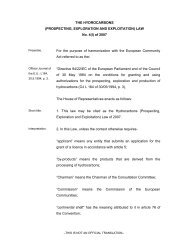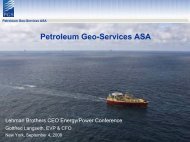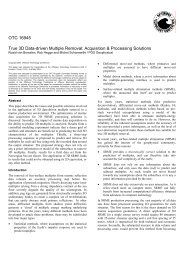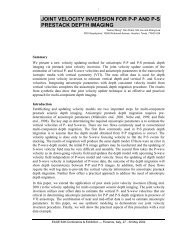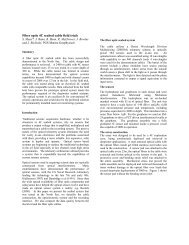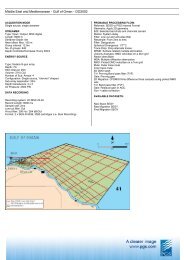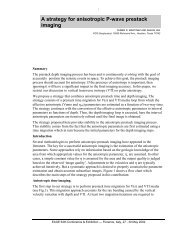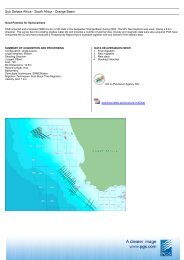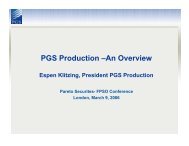Annual Report 2011 - PGS
Annual Report 2011 - PGS
Annual Report 2011 - PGS
You also want an ePaper? Increase the reach of your titles
YUMPU automatically turns print PDFs into web optimized ePapers that Google loves.
Notes to the consolidated financial statements<br />
NOTES TO THE CONSOLIDATED FINANCIAL STATEMENTS<br />
Property and equipment<br />
Property and equipment are stated at cost, excluding the costs of the day-to-day servicing, less accumulated depreciation and<br />
impairment losses. Depreciation is calculated on a straight-line basis over the useful life of the assets based on cost less<br />
estimated residual values. The estimated useful lives for property and equipment are as follows:<br />
Years<br />
Seismic vessels 25 - 30<br />
Seismic and operations computer equipment 3 - 15<br />
Buildings and related leasehold improvements 1 - 17<br />
Fixture, furniture, fittings and office computers 3 - 5<br />
Major overhaul 3 - 5<br />
Subsequent expenditures and major inspections/overhaul are included in the asset’s carrying amount or recognized as a<br />
separate asset, as appropriate, only when it is probable that future economic benefits associated with the item will flow to the<br />
Company and the cost of the item can be measured reliably. The carrying amount of any replaced part is derecognised. All<br />
other repairs and maintenance are charged to the consolidated statements of operations during the financial period in which<br />
they are incurred.<br />
The assets’ residual values, useful lives and method of depreciation are reviewed, and adjusted if appropriate, at least at each<br />
financial year-end.<br />
Assets under construction are carried at cost, less any impairment loss. Cost includes borrowing costs capitalized in accordance<br />
with the Company’s accounting policy as stated below. Depreciation of these assets commences when the assets are ready for<br />
their intended use.<br />
An item of property and equipment is derecognized upon disposal or when no future economic benefits are expected from its<br />
use or disposal. Any gain or loss arising on derecognition of the asset (calculated as the difference between the net disposal<br />
proceeds and the carrying amount of the asset) is included in the consolidated statements of operations in the year the asset is<br />
derecognized.<br />
Significant spare parts are capitalized with the asset to which they pertain, while other spare parts, consumables and bunkers<br />
are classified as other current assets and stated at cost less any impairment charges.<br />
Borrowing costs<br />
Borrowing costs directly attributable to the acquisition, construction or production of qualifying assets, which are assets that<br />
necessarily take a substantial period of time to get ready for their intended use or sale, are added to the cost of those assets,<br />
until such time as the assets are substantially ready for their intended use or sale. Investment income earned on the temporary<br />
investment of specific borrowings pending their expenditure on qualifying assets is deducted from the borrowing costs eligible<br />
for capitalization. All other borrowing costs are expensed as incurred.<br />
Steaming costs<br />
Steaming costs relate to relocating or “steaming” a vessel or crew from one location to another. The Company includes such<br />
costs in the cost of the MultiClient survey or exclusive contract with which the costs are associated. The steaming costs related<br />
to MultiClient survey are capitalized as a part of the MultiClient library (see above). Steaming costs on exclusive surveys are<br />
deferred and charged to expense based upon the percentage of completion of the project.<br />
Both for MultiClient and exclusive surveys the estimated probable future economic inflows which are documented at inception<br />
must cover the costs capitalized or deferred. If the projects are not able to cover all of the costs which could be capitalized or<br />
deferred then only those costs that are recoverable (discounted cash inflow of the project or activity undertaken exceeds the<br />
discounted cash outflow) are capitalized/deferred.<br />
Impairment of property, equipment and intangibles<br />
The Company reviews the carrying amounts of its tangible and intangible assets to determine whether there is any indication<br />
that those assets have been impaired. If any such indication exists, or when annual impairment testing for an asset is required,<br />
the recoverable amount of the asset is estimated in order to determine the extent of the impairment loss (if any). An asset’s<br />
recoverable amount is the higher of an asset’s or cash generating unit’s fair value less cost to sell and its value in use and is<br />
determined for an individual asset, unless the asset does not generate cash inflows that are largely independent of those from<br />
other assets or groups of assets. In assessing value in use, the estimated future cash flows are discounted to their present<br />
value using a discount rate that reflects current market assessments of the time value of money and the risks specific to the<br />
asset for which the estimates of future cash flows have not been adjusted. If the recoverable amount of an asset (or cashgenerating<br />
unit) is estimated to be less than its carrying amount, the carrying amount of the asset (cash-generating unit) is<br />
reduced to its recoverable amount. An impairment loss is recognized immediately and presented separately in the consolidated<br />
statements of operations.<br />
Goodwill does not generate cash flows independently of other assets or groups of assets and is allocated to the cashgenerating<br />
units expected to benefit from the synergies of the combination that gave rise to the goodwill. Upon internal<br />
reorganization goodwill is allocated to the new cash-generating units based on the relative fair value.<br />
Where a reasonable and consistent basis of allocation can be identified, corporate assets are also allocated to individual cashgenerating<br />
units, or otherwise they are allocated to the smallest group of cash-generating units for which a reasonable and<br />
consistent allocation basis can be identified.<br />
<strong>PGS</strong> ANNUAL REPORT <strong>2011</strong> 6<br />
<strong>PGS</strong> <strong>Annual</strong> <strong>Report</strong> <strong>2011</strong> 77



